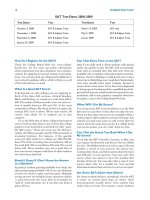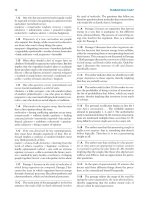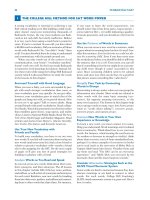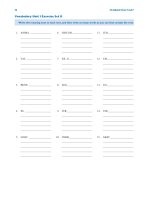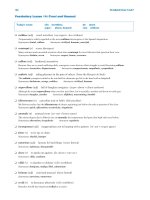Sat - MC Grawhill part 20 pptx
Bạn đang xem bản rút gọn của tài liệu. Xem và tải ngay bản đầy đủ của tài liệu tại đây (153.18 KB, 10 trang )
SAT Practice 3:
Finding Patterns in the Structure of the Passage
180 MCGRAW-HILL’S SAT
of spontaneous generation arise from this
mortal blow.”
50 All living organisms share a common ances-
tor, most likely a population of colonial
microorganisms that lived almost 4 billion
years ago. This common ancestor was itself
the product of a long period of prebiotic
55 assembly of nonliving matter, including
organic molecules and water, to form
self-replicating units. All living organisms
retain a fundamental chemical composition
inherited from their ancient common
60 ancestor.
1. Throughout the passage, the word “spontaneous”
can best be taken to mean
(A) without reproductive elements
(B) in a medium
(C) unthinking
(D) free-spirited
(E) adult
2. In Pasteur’s experiment, why was the neck of the
flask removed?
(A) to allow the air to escape
(B) to provide access to microorganisms
(C) to kill any microorganisms that may be
present
(D) to permit the heating of the flask
(E) to introduce fermentable material
3. In line 49, the word “mortal” most nearly means
(A) human
(B) impermanent
(C) fatal
(D) earthly
(E) malicious
The following passage, from a text on the princi-
ples of zoology, discusses theories of biogenesis,
the process by which life forms are created.
From ancient times, people commonly
believed that life arose repeatedly by sponta-
Line neous generation from nonliving material in
addition to parental reproduction. For exam-
5 ple, frogs appeared to arise from damp earth,
mice from putrefied matter, insects from
dew, and maggots from decaying meat.
Warmth, moisture, sunlight, and even
starlight often were mentioned as factors that
10 encouraged spontaneous generation of living
organisms.
Among the accounts of early efforts to syn-
thesize organisms in the laboratory is a recipe
for making mice, given by the Belgian plant
15 nutritionist Jean Baptiste van Helmont
(1648). “If you press a piece of underwear
soiled with sweat together with some wheat
in an open jar, after about 21 days the odor
changes and the ferment. . . . changes the
20 wheat into mice. But what is more remarkable
is that the mice which came out of the wheat
and underwear were not small mice, not even
miniature adults or aborted mice, but adult
mice emerge!”
25 In 1861, the great French scientist Louis
Pasteur convinced scientists that living
organisms cannot arise spontaneously from
nonliving matter. In his famous experi-
ments, Pasteur introduced fermentable
30 material into a flask with a long s-shaped
neck that was open to air. The flask and its
contents were then boiled for a long time to
kill any microorganisms that might be pre-
sent. Afterward the flask was cooled and left
35 undisturbed. No fermentation occurred
because all organisms that entered the open
end were deposited in the neck and did not
reach the fermentable material. When the
neck of the flask was removed, micro-
40 organisms in the air promptly entered the
fermentable material and proliferated.
Pasteur concluded that life could not
originate in the absence of previously
existing organisms and their reproductive
45 elements, such as eggs and spores. Announc-
ing his results to the French Academy,
Pasteur proclaimed, “Never will the doctrine
Cleveland Hickman, Larry Roberts, and Allan Larson, Integrated
Principles of Zoology. © 2001 McGraw-Hill. Reprinted by
permission of The McGraw-Hill Companies.
CHAPTER 4 / CRITICAL READING SKILLS 181
4. If both Pasteur’s conclusion that “life could
not originate in the absence of . . . eggs and
spores” (lines 42–45) and the statement, “This
common ancestor . . . units” (lines 53–57) are
true, then which of the following statements also
must be true about “prebiotic assembly” (lines
54–55)?
(A) It is not a “spontaneous” process.
(B) It does not depend on sunlight.
(C) It produces molecules unlike those in
current life forms.
(D) It occurs in the absence of water.
(E) It occurs very quickly.
5. The author of this passage would likely agree
with all of the following statements EXCEPT
(A) Jean Baptiste van Helmont’s efforts to syn-
thesize organisms were poorly controlled.
(B) Life on earth began about 4 billion years ago.
(C) Nonliving matter cannot form units that can
reproduce themselves.
(D) The chemical makeup of organisms must be
fundamentally similar to that of their parents.
(E) Carefully controlled experiments can
disprove even widely held biological theories.
6. The theory of biogenesis described in lines 50–60
shares what common element with the theory of
spontaneous generation described in lines 1–11?
(A) a single common ancestor
(B) water as an essential reactant
(C) the process of fermentation
(D) sexual reproduction
(E) decaying organisms
Answer Key 3:
Finding Patterns in the Structure of the Passage
182 MCGRAW-HILL’S SAT
4. The introduction of the conflict, the development
of the conflict, and the resolution of the conflict
5. Studies, authoritative quotes, anecdotes, statistics,
logical analysis, examples, etc.
Concept Review 3
1. The structure of the passage is the way that indi-
vidual paragraphs work together to convey the
central idea of the passage.
2. The paragraph
3. The introduction, the development, and the
conclusion
SAT Practice 3
1. A The theory of “spontaneous generation” is
described as one in which life arises from sub-
stances that do not contain the reproductive ele-
ments of that life form.
2. B The important difference between the flask
with the neck intact and the flask with the neck
removed was the presence of microorganisms in
the fermentable material. When the neck was
removed, “microorganisms in the air promptly
entered the fermentable material and proliferated.”
3. C The experiment, Pasteur claimed, “killed” the
theory of spontaneous generation, so it dealt a
fatal blow.
4. A The “prebiotic assembly” is said to occur over
a “long period.” This must not be an example of
“spontaneous generation,” that is, generation of
life over a short period of time from nonliving
material, because the theory of spontaneous gen-
eration has been disproven.
5. C The author clearly believes that van Helmont’s
study was poorly controlled and that controlled
experiments can disprove widely held theories
because van Helmont’s theory was refuted when
Pasteur imposed tighter controls. He also states
that all living organisms derived from an ancestor
“that lived almost 4 billion years ago” (lines 52–53)
and that they “retain a fundamental chemical com-
position inherited from their ancient common
ancestor” (lines 58–60). However, the author
would not agree that “nonliving matter cannot
form units that can reproduce themselves” be-
cause he describes just such matter in lines 53–57.
6. B The theory of spontaneous generation
described in lines 1–11 mentions “damp earth,”
“dew,” and “moisture” as “factors that encouraged
spontaneous generation.” The theory of biogene-
sis described in lines 50–60 states that water is an
essential element of prebiotic assembly.
CHAPTER 4 / CRITICAL READING SKILLS 183
Lesson 4: Simplifying the Passage
Simplify by Paraphrasing
When you read, your brain is not a CD burner: It
doesn’t just record all the information for perfect
recall. You need to train your brain to process the
information into simpler forms. This is called para-
phrasing, summarizing paragraphs and passages in a
few tidy words.
Good readers constantly paraphrase paragraphs
as they read. Don’t worry—it doesn’t waste time. With
practice, paraphrasing will actually save you time on
the reading section. Having the key ideas fresh in
your mind helps you to zero in on the right answers.
As you read SAT passages, practice paraphras-
ing each paragraph. You may want to write
each summary in the margin. Be as concise as
possible, but capture the key idea. For in-
stance, “This paragraph is about dolphins and
their intelligence” is a poor summary because
it doesn’t capture the key idea, just the topic. A
better summary is “Dolphins have communi-
cation skills that other mammals lack.” If it’s
relevant, make a quick note of how the para-
graph relates to the previous paragraph. Does
it provide an example of a concept described
previously? Does it describe a situation that
contrasts with the previous one?
Simplify, but Don’t Oversimplify
Avoid test-taking tricks that oversimplify SAT CR ques-
tions. Two of the most popular tricks in SAT courses
and books are the “chuck the extremes” trick and the
“don’t dis the minorities” trick. As with many simplistic
shortcuts, they don’t work so well. They assume that the
right answers to SAT questions are never “extreme,”
particularly if they pertain to reading passages about
minorities or women. So, they say, just eliminate any
choices that take an extremely positive or negative tone,
and eliminate all answers with a negative tone if the pas-
sage pertains to a minority or minority group “because
the SAT will never disparage minorities.”
The problem is that the SAT always knows how to
thwart these shortcuts, to force students to read to get
the right answer, rather than just apply a test-taking
trick. For instance, the “minority” passage on the May
2006 SAT was a story about two Asian-American
poets. Here are two of the questions:
The tone of the characterizations quoted in lines
11–12 is best described as
(A) morose
(B) curious
(C) sardonic
(D) threatening
(E) incredulous
The tone of the statement in line 20 is best
described as
(A) impatient
(B) apologetic
(C) reflective
(D) anxious
(E) unconvinced
Nationwide, thousands of students who had taken
SAT courses were confident that they could “crack” these
questions. Because the passage concerns American mi-
norities, the tone of the correct answers must be positive,
right? In question 12, the only choice with a positive tone
is (B), and in question 13, the only one is (C). Easy!
But wrong. Even a cursory reading would reveal
the correct answers to be (C) sardonic and (E) uncon-
vinced, respectively. Pretty negative, huh? Of course,
SAT passages are not disparaging of minority groups,
but this fact is not so easy to translate into a quick-and-
easy test-taking trick as some would like you to believe.
Simplify by Visualizing
Visualization increases your brain’s ability to absorb
information. After all, “a picture is worth a thousand
words,” right? Visualizing as you read increases your
interest as well as your retention. Visualizing a narra-
tive is relatively simple because narratives contain
characters and action. But how do you visualize an
analysis or argument?
• When reading an analysis, visualize the sub-
ject matter as best you can. For instance, if
it’s about life in 15th–century Italy, picture
a map of Italy, and visualize the people in
dress of the times. If it’s about the discovery
of a quasar, visualize the pulsing star and
the astronomers gazing at it through tele-
scopes, and perhaps visualize a timeline of
the discoveries.
• When you read an argument, visualize a battle
with the author’s thesis on one side battling
the opposing thesis. It’s very important to “see”
the two sides. The explanations and examples
are like “weapons” against the enemy.
Concept Review 4: Simplifying the Passage
184 MCGRAW-HILL’S SAT
1. What should you visualize when reading a narrative?
2. What should you visualize when reading an argument?
3. What should you visualize when reading an analysis?
4. What questions should you answer at the end of each paragraph?
Practice paraphrasing by writing a quick summary after each paragraph.
5. When examined closely, “raising standards” does not often have the effect of improving education, despite all the
rhetoric. When this game—and it is largely a game—is played right, the statistics improve, and its proponents
claim victory. But we can do all sorts of horrible things to students in order to improve educational statistics:
kick out slow learners, encourage cheating, employ superficial tests that are easily coached but reflect no real
academic skill, and so on. We think that by saying we’re “raising standards,” we are challenging our children
more intensely, and thereby producing smarter and more mature kids. For the most part, it’s a con game, and
we’re all being taken in.
___________________________________________________________________________________________________
___________________________________________________________________________________________________
___________________________________________________________________________________________________
6. Art historians and aestheticians have long been confounded by Dadaism’s complexities and seeming paradoxes.
Few seem able to express its real meaning. Dadaism imbues art with the outrageous and the whimsical, but it
is a mistake to think that it is mere child’s play. It is a profound expression of art as life in the moment. Its works
have sadly been lost on a public that expects erudition, archetypes, and allusions in its art, rather than the exu-
berance of life that art should be.
___________________________________________________________________________________________________
___________________________________________________________________________________________________
___________________________________________________________________________________________________
CHAPTER 4 / CRITICAL READING SKILLS 185
SAT Practice 4: Simplifying the Passage
decision to stay home. You just give a rea-
son why you don’t want to, and your friend
understands.
50 This convenience persuades us that teleo-
logical explanations are the best for analyzing
human behavior. Furthermore, we resist
mechanistic explanations of behavior because
55 they seem to deny another preciously guarded
concept: free will. If our decision to stay home
from a party could be explained in the same
way that the action of an internal combustion
engine can be explained, then doesn’t that
60 reduce us all to mindless machines?
No: the mind’s understanding of the mind
will always leave room for “free will,” what-
ever that really means. Full understanding of
a phenomenon depends on the mind’s ability
65 to detach from and observe it, and the mind
can never fully detach from itself. This com-
plication may imply that a full understanding
of the human mind is impossible, but it does
not imply that we must be satisfied with mere
70 teleology. Perhaps this will require an entirely
new conception of psychology, but if psychol-
ogy is to remain relevant, we have no other
choice.
1. Which of the following is the best title for this
passage?
(A) Why Mechanism Should Replace Teleology
(B) The Science of the Ancient Greeks
(C) The Psychology of Wants and Needs
(D) The Causes of Scientific Ignorance
(E) Obstacles to a Full Understanding of the
Mind
2. Which of the following is an example of a “teleo-
logical” explanation?
(A) water evaporates because it absorbs heat
(B) an engine works because it burns fuel
(C) a bird sings because it likes the sound
(D) a dog yelps because it perceives pain
(E) a ball falls because a gravitational field
pulls it
The following passage discusses the philosophi-
cal distinction between two methods of explain-
ing scientific phenomena.
As our theories about the world around us have
evolved and have become more useful, they
Line have become, almost without exception, less
teleological and more mechanistic. A teleolog-
5 ical explanation of a phenomenon describes
causes and effects in terms of desires or pur-
poses: something happens simply because it
serves a certain purpose, because it is “sup-
posed” to happen, or because someone or
10 something “wants” it to happen. A ball falls to
earth because, as it is in the air, it perceives that
its more proper place is on the ground, and not
because anything pushes it. Teleological
explanations never survive as useful theories
15 because they are backward: they place the
cause after the effect.
A mechanistic explanation, on the other
hand, requires that any discussion of causes
and effects be restricted by the known laws of
20 how physical objects and substances interact
as time moves forward. This is the language of
the scientist. No right-minded chemist would
say that trinitrotoluene explodes because it
“wants to.” It does so because the presence of
25 heat and oxygen releases the potential energy
stored in its bonds.
Early scientific theories were almost exclu-
sively teleological. If you could drive Socrates
around in an SUV, he would be far more
30 likely to ask you about your vehicle’s nature, or
its desires, or its soul than about how the engine
worked, how the odometer received its infor-
mation, or how the different buttons on the CD
player produced their effects. It would
35 seem to him that he was in the belly of a metal-
lic animal, or at least a possessed machine.
Teleological explanations are convenient for
explaining what people do, because most of us
understand the concepts of “wants” and
40 “needs” far more deeply than we understand
the mind’s mechanisms for processing infor-
mation. If you only have three minutes to
explain to your friend why you are not going to
a party, you don’t very well have the knowledge,
45 not to mention the time or desire, to explain
how your cerebral cortex processed the
information and concepts associated with the
© 2004 Christopher Black. All rights reserved. Reprinted by
permission of the author.
186 MCGRAW-HILL’S SAT
6. Which of the following best describes the charac-
terizations of the “machine” in line 36 and the
“machines” in line 60?
(A) The “machine” is modern, but the “machines”
are ancient.
(B) The “machine” obeys mechanistic physical
laws, but the “machines” do not.
(C) The “machine” cannot be explained teleolog-
ically, but the “machines” can.
(D) The “machine” is simple, but the “machines”
are not.
(E) The “machine” is thought to have a soul,
but the “machines” have had their souls
diminished.
3. The reference to Socrates (lines 28–36)
emphasizes the fact that he was
(A) more influential than other Greek
philosophers
(B) fearful of complicated machines
(C) concerned more with ethics than with
physics
(D) aware of the mechanistic laws of physics
(E) inclined to explain phenomena in terms of
purposes
4. In line 36, the word “possessed” most nearly means
(A) owned
(B) willful
(C) purchased
(D) determined
(E) spontaneous
5. The fourth paragraph (lines 37–49) suggests that
teleological explanations persist chiefly because
they
(A) are easier to use
(B) are more logically consistent
(C) agree with physical laws
(D) deny free will
(E) explain physical phenomena accurately
CHAPTER 4 / CRITICAL READING SKILLS 187
Answer Key 4: Simplifying the Passage
imagine watching a documentary about those an-
imals as the “narrator” speaks.
4. What is the main idea of the paragraph? How does
it relate to the previous paragraph? How does it
support the central idea of the passage?
5. “Raising standards” can have many negative effects
like cheating, unfairness, and superficial learning.
6. Dadaism is not silly or irrelevant; it is the expres-
sion of life in the moment.
Concept Review 4
1. Visualize the characters and the action in vivid
detail. Pay close attention to the conflict or problem
in the story.
2. Visualize a physical battle between the opposing
viewpoints in the argument. Imagine each rhetor-
ical device as a weapon against the enemy.
3. Visualize the subject matter as best you can. If it is
a historical analysis, try to visualize a map of the
region being discussed, and visualize the people in
dress of the times. If it is about animals, try to
SAT Practice 4
1. A The passage compares mechanistic explana-
tions to teleological ones and explains why mech-
anistic ones are “more useful.” Choices (B), (C),
and (D) describe tasks that go far beyond what this
passage accomplishes, and choice (E) describes an
idea that is mentioned only in the last paragraph.
2. C “Teleological” explanations are those that
“describe causes and effects in terms of desires or
purposes.” Saying that a bird sings because it
“likes the sound” implies that the bird’s action is
caused by a desire.
3. E Socrates is said to “be far more likely to ask
you about your vehicle’s nature, or its desires, or
its soul than about how the engine worked.” This
underscores the author’s belief that Socrates
explained things in terms of their “purposes.”
4. B Socrates, the author tells us, would believe
that the SUV possessed a soul, so the “possessed
machine” is one with a living spirit and will.
5. A The fourth paragraph tells us that teleological
explanations “are convenient,” and goes on to ex-
plain why people continue to use them.
6. E The “possessed machine” in line 36 is the SUV
that Socrates would believe has a soul. The “mind-
less machines” of line 60 represent the conception
of human beings that many would have if
human behavior were explained “mechanisti-
cally,” thereby removing (they would think) our
free will and soul.
Lesson 5:
Connecting the Questions to the Passage
188 MCGRAW-HILL’S SAT
Think of Your Own Answer First
After answering the three key questions for
yourself, attack the SAT questions by following
these steps:
1. Read each question carefully, covering up
the answer choices for now.
2. Translate it into a “stand-alone” question, if
possible.
3. Formulate your own answer to the trans-
lated question.
4. Choose the best match among the choices.
This strategy takes advantage of the work
you’ve done answering the key questions, and
keeps you from getting “talked into” wrong
answers that only look good.
For instance, a question such as “The passage
suggests that most people do not notice bias in the
media because . . .” can be translated into the open-
ended question. “Why [according to this author]
don’t people notice bias in the media?” Answer this
question on your own, then find the best match
among the choices.
Know the 6 Question Types
1. Purpose questions ask why the author wrote the
passage or used some particular word or lines, as
in “The reference to the ‘tragedy’ (line 16) primar-
ily serves to. . . .” These questions usually contain
key phrases such as “in order to” or “primarily
serves to.” To tackle these questions, first remind
yourself of the purpose of the whole passage, and
then of the paragraph, then of any line references.
2. Central idea questions ask you to summarize the
central idea or make an inference based on the
author’s position, as in “Which of the following is
the best title of this passage?” or “With which of the
following statements would the author most likely
agree?” To tackle these questions, remind yourself of
the central idea before checking the choices.
3. Secondary idea questions ask you to identify the
main ideas of individual paragraphs rather than
of the passage as a whole, as in “The ‘problems’
mentioned in line 56 are those of . . .” or “The third
paragraph suggests. . . .” To tackle these questions,
reread the specified lines—sticking to the specified
lines and perhaps the sentence before—and summa-
rize them before checking the choices.
4. Tone questions ask you about the attitude of the au-
thor or the tone of particular characterizations. To
tackle tone questions, pay attention when the author
is being funny, critical, condescending, or objective.
5. Word or phrase in context questions ask you what
a particular word or phrase means in the context
of a sentence. To tackle these questions, reread the
specific sentence, translate the given word into your
own word, and compare this to the choices.
6. Structure or device questions ask you about the rela-
tionship between paragraphs or the author’s use of
such devices as anecdotes, authoritative references,
statistics, metaphors, counterexamples, and such. To
tackle these questions, pay particular attention to such
devices as you read analyses or arguments.
Check the Line References
Always carefully reread any words or lines the
question refers to, with the question type in
mind. For instance, if the question is a “purpose”
question—using a phrase such as “in order to”—
reread the words or lines asking, “What purpose
does this word, phrase, or reference have in this
discussion?” If it is a “secondary idea”
question—using a word such as “suggests,” “rep-
resents,” or “means”—reread the words or lines
asking, “What does the author mean by that?”
Use the “Sandwich Strategy” to Find the
Answer
Unlike questions on other SAT sections, CR
questions do not go in order of increasing diffi-
culty. Rather, they follow the order of the passage.
Generally, the first questions are about the be-
ginning of the passage, and the last questions are
about the end of the passage. Use the “sandwich
strategy” to answer questions without line refer-
ences. For instance, if question 23 does not con-
tain a line reference, but question 22 refers to
line 15 and question 24 refers to line 25, then the
answer to question 23 is probably “sandwiched”
between lines 15 and 25!
CHAPTER 4 / CRITICAL READING SKILLS 189
Concept Review 5:
Connecting the Questions to the Passage
1. What are the four steps to effectively attacking SAT CR questions?
2. What does it mean to translate SAT CR questions into “stand-alone” questions?
3. Why is it important to translate SAT CR questions into “stand-alone” questions whenever possible?
4. Translate each of the following questions into a “stand-alone” open-ended essay question:
a. “The author’s attitude toward the opposition (line 42) is one of . . .”
b. “The garden has become important to the author because . . .”
c. “The last paragraph suggests that Davis is motivated by . . .”
d. “The author refers to the freedom of estuary birds in lines 1–2 in order to emphasize the fact that . . .”
e. “The author uses the term solid (line 16) primarily in order to . . .”
5. What is the “sandwich strategy”?
6. How should you attack a question that contains the phrase “in order to”?


